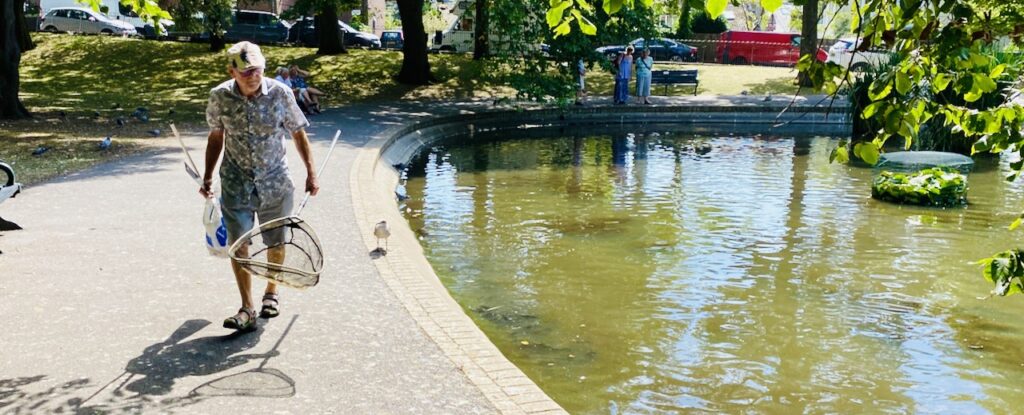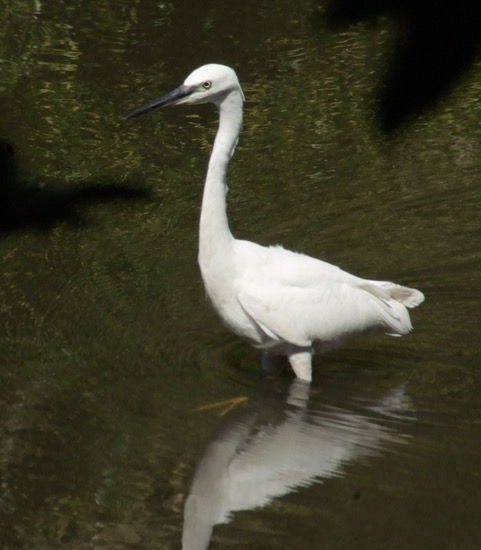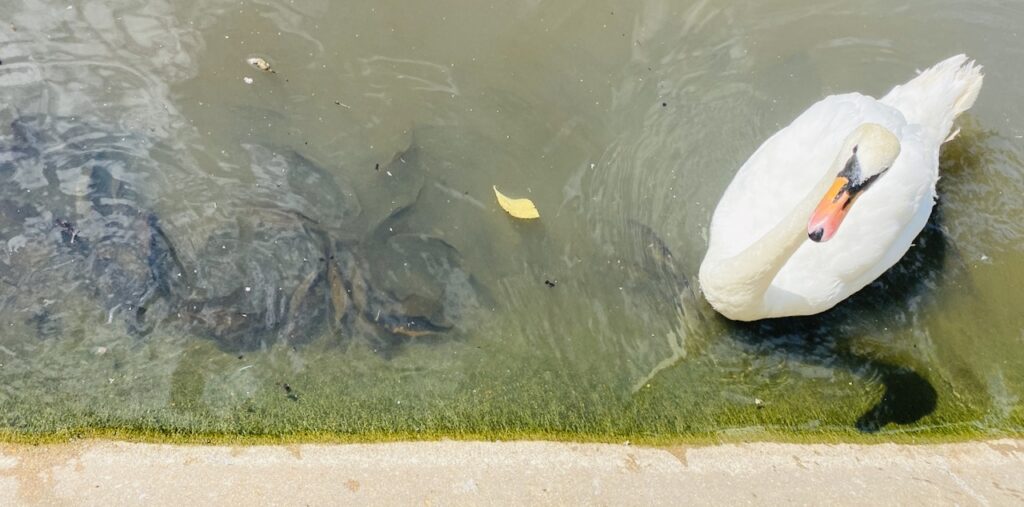Q&A with Chris Lowe
Posted Wednesday August 12, 2020
Chris Lowe of the Friends Of Queens Park is a keen naturalist who spends many hours tending and caring for the pond in Queens Park. In response to questions from concerned residents, he answers some of the pressing issues of recent weeks.

Chris Lowe
Hi Chris – can you tell us what’s up with the Swans?
The Swans harassment of other pond birds, including their own 2019 cygnets, seems to have calmed down. However one of this year’s Cygnets is missing – fate unknown. News anyone?
What about other bird news?
An exquisite Little Egret (a member of the heron family) has made itself at home at the northern end of the pond. Little Egrets first arrived in Britain from France in the 1990s and are now breeding in river estuaries and lakes along the South Coast. They nest in trees.

Egret
It has been a good year for the swifts, with a growing swift colony. and they’ve been nesting in my house on Queens Park Road for the first time in 20 years. This is thanks to people putting up nest boxes and small holes in the facia to attract the swifts.
What is the status of the new dipping platform?
Progress has been held up by lockdown and wheels are turning slowly with installing non-slip strips. This, we think is both safer and more elegant. A secure gate and length of roll top fencing have been made up pending installation, although, frankly, we’re not crazy about this initiative because it is unsightly and will make almost no difference to safety.


Fish (left), Swan (right)
A lot of people have noticed fish and even terrapins in the pond. How did they get there?
When the pond was refilled in 2011, our then city ecologist advised not to restock it with fish (it had Common Carp in it before) particularly carp, as they are bottom feeders and by stirring up the mud they release nutrients into the water which lowers the oxygen content. The fish you see now are descendants of fish dumped by one or more members of the public.
The biggest shock to me has been the sudden appearance of not tens but hundreds of large goldfish, or small Koi carp. The latter seems much more likely as they come in a wider range of colours than goldfish including black. If they are Koi, which grow to two to three feet in length we may have a problem!
They are unwelcome for the above reasons and the fact that they are being preyed upon by visiting Herons, Herring Gulls and, this morning, a ‘Little Egret’ is welcome as far as I am concerned. Let nature takes it course.
The terrapins are also dumped. We presently have three, and you can occasionally see them sunbathing on the island. Terrapins, we’re told, bite the duck’s feet causing pain, infections and often death, so it’s an acute example of a new species breaking the delicate ecology of the pond.
Members of the public depositing unwanted pets in the pond is really not welcome. [*] If this continues, we may be forced to do something quite drastic like like empty the pond to remove them.
[*] It is against the law to dump fish in public waterways. See Wildlife and Countryside Act 1981
“People looking to release unwanted pet fish into local ponds and lakes are urged to find alternatives as this can have a devastating impact on native species and ecosystems.
Ornamental fish such as goldfish and koi carp can carry disease and parasites which can have a devastating effect on coarse fish populations and have major commercial impacts on fisheries.
They should be kept in garden ponds and not transferred into the wild. As well as the risk of disease, goldfish and carp can also interbreed with crucian carp, a threatened species, leaving ponds with hybrid populations.
Keith Davenport, Chief Executive of the Ornamental Aquatic Trade Association Ltd said:
If you choose to own a pet this is a commitment to keep that animal for its lifetime.
However, if for any reason you cannot keep your pet for the whole of its life then you should make suitable arrangements to rehome it, making sure of course the new owner has full accurate details of the care it requires. Pet shops, pet societies or rehoming groups may be able to assist.
Any rehoming must only be done with whoever accepts the fish being fully aware that in saving one fish they may jeopardise the biosecurity of those they already have.
Jerome Masters, fisheries technical officer at the Environment Agency said:
Fish movements are regulated by the Environment Agency. Releasing fish into the wild or moving them between or into fisheries without getting consent from the Environment Agency is an offence under the Keeping and Introduction of Fish Regulations 2015.
Many pet fish will be unsuited for life in the wild and so their release could also be an offence under the Animal Welfare Act 2006.
Angling clubs wishing to move or introduce any fish are required to register their fisheries with the Centre for Environment, Aquaculture and Fisheries Science (Cefas) and obtain a site permit from the Environment Agency. The permit details the species that can be kept in the fishery.
A permit is also needed if the fishery contains non-native fish. Introductions or movements may require health checks to be carried out on a sample of fish before they can be consented.
These controls are in place to manage the risks posed by spreading non-native fish species and fish parasites, and of inappropriate stocking.”